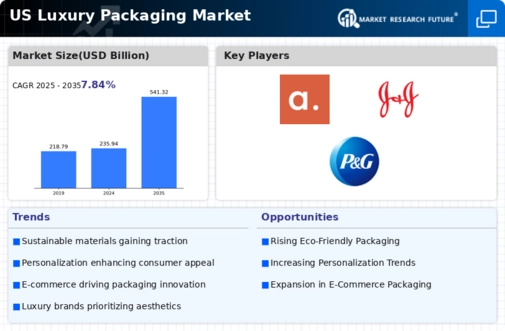Influence of Brand Image and Aesthetics
In the luxury packaging market, brand image and aesthetics play a pivotal role in shaping consumer perceptions. Packaging serves as a visual representation of a brand's identity, and companies are increasingly investing in design elements that reflect their values and ethos. The luxury packaging market is characterized by a focus on high-end materials, intricate designs, and attention to detail, which collectively enhance the perceived value of products. As consumers become more discerning, the aesthetic appeal of packaging is likely to influence their purchasing decisions. In 2025, it is estimated that approximately 40% of consumers will prioritize packaging design when selecting luxury products. This trend underscores the importance of creating visually striking packaging that not only attracts attention but also reinforces brand loyalty and recognition.
Sustainability as a Competitive Advantage
Sustainability is emerging as a critical driver in the luxury packaging market, with brands increasingly recognizing its importance in attracting environmentally conscious consumers. The luxury packaging market is witnessing a shift towards eco-friendly materials and practices, as companies strive to reduce their environmental footprint. In 2025, it is anticipated that sustainable packaging solutions will account for nearly 25% of the luxury packaging market. Brands that adopt sustainable practices are likely to gain a competitive advantage, as consumers are more inclined to support companies that align with their values. This trend is prompting luxury brands to explore biodegradable materials, recyclable designs, and minimalistic packaging that reduces waste. By prioritizing sustainability, companies not only enhance their brand image but also contribute to a more sustainable future.
E-commerce Growth and Packaging Innovations
The rapid expansion of e-commerce is significantly impacting the luxury packaging market. As online shopping becomes increasingly prevalent, brands are compelled to adapt their packaging strategies to ensure that products arrive in pristine condition while maintaining a luxurious presentation. The luxury packaging market is projected to grow at a CAGR of 5.5% through 2025, largely fueled by the e-commerce sector. This growth necessitates innovative packaging solutions that not only protect products during transit but also enhance the overall customer experience. Brands are exploring sustainable and aesthetically pleasing materials that align with their luxury image while meeting the demands of online consumers. The integration of technology, such as QR codes and augmented reality, into packaging is also becoming more common, allowing brands to engage customers in new and exciting ways.
Rising Consumer Demand for Premium Products
The luxury packaging market is experiencing a notable surge in consumer demand for premium products. As disposable income levels rise, particularly among affluent demographics, consumers are increasingly willing to invest in high-quality goods that offer a sense of exclusivity. This trend is reflected in the luxury packaging market, where brands are focusing on enhancing the unboxing experience through sophisticated packaging solutions. In 2025, the luxury packaging market is projected to reach a valuation of approximately $30 billion in the US, driven by this growing consumer preference for premium offerings. Brands are recognizing that packaging plays a crucial role in conveying quality and prestige, thereby influencing purchasing decisions. Consequently, companies are investing in innovative designs and materials that resonate with the luxury consumer's desire for uniqueness and elegance.
Technological Advancements in Packaging Solutions
Technological advancements are reshaping the luxury packaging market, offering innovative solutions that enhance both functionality and aesthetics. The integration of smart packaging technologies, such as NFC tags and temperature-sensitive materials, is becoming increasingly prevalent. These innovations allow brands to provide consumers with interactive experiences and ensure product integrity. The luxury packaging market is projected to see a growth rate of 6% annually, driven by these technological advancements. Companies are investing in research and development to create packaging that not only protects products but also engages consumers on a deeper level. As technology continues to evolve, the luxury packaging market is likely to witness the emergence of new materials and designs that cater to the sophisticated tastes of luxury consumers.














Leave a Comment